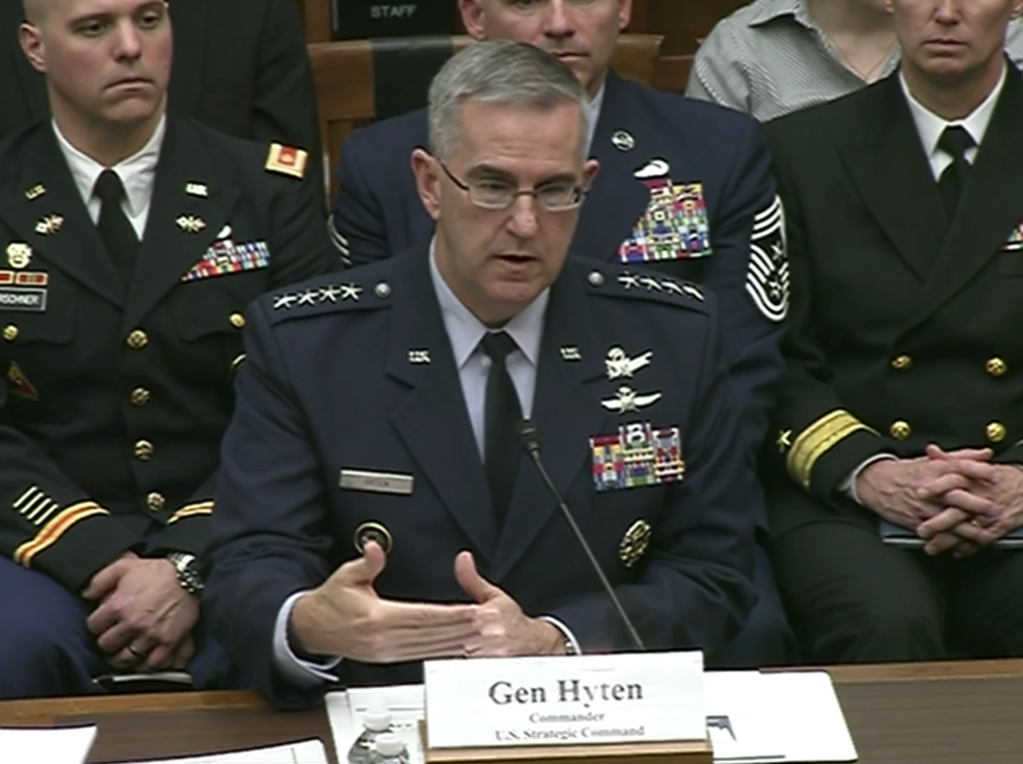
Gen. John Hyten, commander of US Strategic Command, speaks Wednesday at a House Armed Services Committee hearing. Screenshot photo
??Key House Armed Services members expressed concerns Wednesday about the adequacy of the U.S. nuclear deterrence and missile defenses in light of growing capabilities of Russia, China and other nations, but the top Pentagon official on nuclear policy and the commander of U.S. Strategic Command said nuclear deterrence still works and the missile defenses meet current threats.
John Rood, undersecretary of defense for Policy, and STRATCOM boss Gen. John Hyten said the threats are growing and urged congressional support for existing programs to modernize and expand the ballistic missile defense systems, and add two new weapons to the nuclear deterrent arsenal.
Although US strategic capabilities remain “the strongest in the world, our advantage is eroding,” Rood told the House Armed Services Strategic Forces subcommittee.
“Our task is to ensure the U.S. advantages endure … But we are fully capable of meeting the increasing challenges to our security,” Rood said.
“The forces under my command are full ready to address all threats … No one out there should doubt that,” Hyten said.
But he added, “we must guarantee that future strategic commanders can say that.”
In opening his subcommittee’s hearing, Chairman Rep. Mike Rogers (R-Ala.) observed that in discussing the new Nuclear Posture Review and the missile defense systems they must acknowledge “that the nuclear security environment has deteriorated dramatically in recent years.”
Noting the recent belligerent declaration by Russian President Vladimir Putin that Russia had developed “invincible” nuclear weapons, Rogers asked if the US missile defense could deal with that.
The current strategic missile defense system “does not have the capability” to counter the Russian and Chinese ballistic missile arsenals and “was never intended to.” Rood said.
“Regrettably, the missile threat we face around the world continues to grow, and it is important we maintain the ability to counter threats like North Korea,” he added, and cited the planned improvements in the national system, including 20 additional interceptors in Alaska, and additional or improved radars in both Alaska and Hawaii.
Rood and Hyten also strongly supported development of greater sensors in space and new anti-missile capabilities, including directed energy. Rood said creation of a third interceptor field, usually considered on the East Coast, is still being reviewed.
Hyten called for three improvements – better sensors, better kill vehicles, and greater capacity. “I will be constant in pushing for additional capabilities.”
Pressed strongly by Rep. Mo Brooks (R-Ala.) about whether the doctrine of mutually assured destruction, which was the guiding principle for nuclear deterrence throughout the Cold War, was still relevant given the new threats, Rood said, “fundamentals of nuclear deterrence still apply,” but “need to be more flexible” in application because deterrence may work differently for different threats.
That is why, he said, the Nuclear Posture Review included two new nuclear weapons – a low-yield warhead for the submarine-launched Trident ballistic missiles and a submarine-launched nuclear-armed cruise missile.
“We have to upgrade our tool box,” Rood said.
Hyten said he did not think we had to worry about a failure of nuclear deterrence for a decade. But he added, “we have to guard against a miscalculation by our adversaries,” such as Putin’s inference that his lower-yield nukes could prevent a U.S. strategic response. That is why they were pushing the two new nuclear weapons, he said.